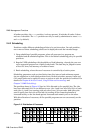The Role of the RMS
• The RMS Daemon, rmsd, runs on each node in the system. It loads and runs user
processes and monitors resource usage and system performance.
The RMS daemons are described in more detail in Chapter 4 (RMS Daemons).
2.3.3 The RMS Commands
RMS commands call on the RMS daemons to get information about the system, to
distribute work across the system, to monitor the state of programs and, in the case of
administrators, to configure the system and back it up. A suite of these RMS client
applications is supplied. There are commands for users and commands for system
administrators.
The user commands for gaining access to the system and running parallel programs are
as follows:
• allocate reserves resources for a user.
• prun loads and runs parallel programs.
• rinfo gets information about the resources in the system.
• rmsexec performs load balancing for the efficient execution of sequential programs.
• rmsquery queries the database. Administrators can also use rmsquery to update
the database.
The system administration commands for managing the system are as follows:
• nodestatus gets and sets node status information.
• rcontrol starts, stops and reconfigures services.
• rmsbuild populates the RMS database with information on a given system.
• rmsctl starts and stops RMS and shows the system status.
• rmshost reports the name of the node hosting the RMS database.
• rmstbladm builds and maintains the database.
• msqladmin performs database server administration.
The services available to the different types of user (application programmer, operator,
system administrator) are subject to access control. Access control restrictions are
embedded in the SQL database, based on standard UNIX group IDs (see
Overview of RMS 2-5


















